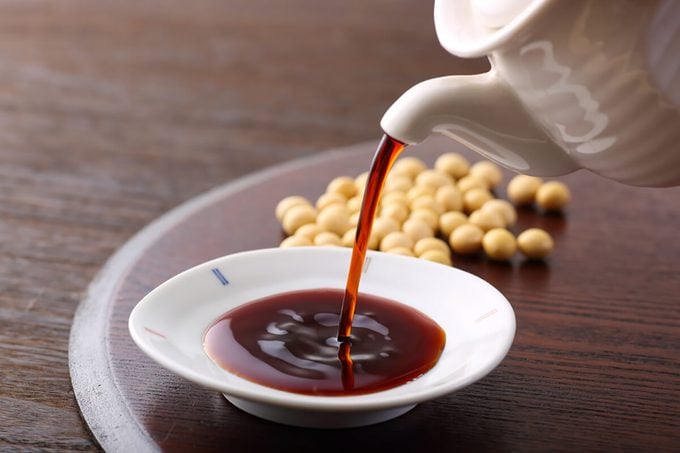Umami: The Tastiest Flavor You’ve Never Heard Of
First "discovered" over 100 years ago, umami, the fifth taste, is finally getting the attention it so justly deserves. Here's why you need to know it.

Cooks all over the world are very familiar with the four tastes in food: sweet, sour, bitter and salt. They are easy to describe and even easier to identify. When you say something like vinegar is sour, everyone knows exactly what you’re talking about. But the four flavors idea all changed in the early 1900s.
A History Lesson in Taste
For centuries, Japanese cooks prepared dashi, a delicious broth made from seaweed that is eaten as a soup or used as an ingredient in other dishes. (Much like our homemade chicken stock!) It wasn’t until 1908 that Japanese chemistry professor Kikunae Ikeda noticed a flavor in his dashi he couldn’t identify as one of the four traditional tastes. He noticed it just tasted good.
About the same time, chef Auguste Escoffier was transforming French cuisine with the introduction of his veal stock. This ingredient was added to sauces, soups and other recipes to enrich each dish with a unique meatiness. While Escoffier focused on using his foundation stock to elevate the flavor of his dishes, it was Ikeda who took his curiosity into the lab to find out exactly what he was tasting.
At what is now the University of Tokyo, Ikeda isolated this savoriness to the amino acid glutamate. He called his discovery “umami,” derived from “umai,” the Japanese word for delicious.
It’s taken over 100 years but the idea of using umami or glutamate-rich foods is now really taking hold. In fact, many people refer to it as the fifth taste. Chefs and home cooks alike are reaching for these glutamate-rich ingredients to give their dishes a savory or meaty flavor boost.
Umami Powerhouses
Parmesan Cheese—This is the most readily available umami-rich ingredient western cooks can reach for. Gram for gram, it packs more glutamate than any other ingredient you’ll find in most grocery stores. The easiest way to add it is to simply sprinkle it on top, like we did with Parmesan Roasted Broccoli.
Dried Tomatoes—While fresh tomatoes contain glutamate, the dried ones really pack an umami punch. Try adding them as a sandwich topper or mix them into hamburgers or Sausage, Artichoke & Sun-Dried Tomato Ragu. Don’t forget to top with some fresh Parmesan cheese for a double umami whammy.
Dried Mushrooms—Just like tomatoes, dried mushrooms add more umami richness than their fresh versions. You’ll find many different varieties, but I tend to reach for dried shiitake or porcini mushrooms. You’ll find both in Mushroom & Wild Rice Soup.
Soy Sauce—More and more cooks are reaching for soy sauce instead of the salt shaker when seasoning dishes, because it not only adds needed sodium but it helps boost the umami in a dish. It’s easy to add to almost any soup or sauce, and it’s a main flavoring in our Moo Shu Lettuce Cups.
Anchovies—Don’t get all squeamish on me now. This little fish packs a wallop when it comes to umami. You don’t need a lot, and in most cases you don’t even know it’s there. It just gives your dish a salty richness you usually can’t quite place, like in this Shrimp Puttanesca.
Potatoes—Something as bland as white potatoes may seem like an odd addition to this list, but they are surprisingly high in glutamate. They’re great to add to dishes since they are relatively inexpensive, they pair well with most foods and, when combined with other umami-rich ingredients, like in Mushroom and Potato Chowder, they create an intensely flavored meal.
Seaweed—While not a common ingredient in Western cooking, seaweed is the granddaddy of all umami ingredients. Gram for gram it has the highest concentration of glutamate of any other ingredient. Most Americans associate seaweed with Sushi Rolls, but nori and other seaweeds are commonly used in many Asian cuisines in soups, salads and other dishes.
Other glutamate-rich ingredients you can reach for include carrots, shellfish (especially shrimp and scallops), garlic, oyster sauce and green tea. Even in smaller amounts they still can pack a punch, especially when combined with other similar ingredients. Take Pork & Shrimp Pinwheels; these appetizers have four umami-packed ingredients (shrimp, soy sauce, oyster sauce and garlic) to really boost the savory flavors. Tsukemono, also known as Japanese pickles, can also be a recipe packed with umami.
I encourage you to play with these ingredients in some of your favorite recipes. I promise you’ll find they taste meatier, more savory and heartier than before.



